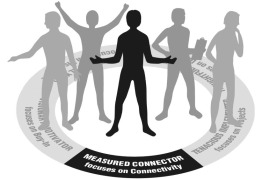There was a time when organisations tended to be hierarchical, often led in a command and control fashion and had few dealings with other organisations unless they were suppliers or direct customers.
Today, we have a complex world in which change is endemic, organisations’ boundaries are permeable (with outsourcing, strategic partnerships, multi-agency working, etc.) and there are challenges which one sole leader (the heroic leader) cannot possibly hope to deal with.
In today’s world where outcomes will often be achieved by a number of different sections, departments or, indeed, organisations and agencies, Measured Connectors will step into their leadership role by demonstrating authoritative (not authoritarian) leadership and systems thinking. A good example of a Measured Connector is Tim Smit who transformed a derelict Cornish quarry into the Eden Project, which has 100,000 plants from around the world and includes the world’s largest greenhouse. He managed to connect people from all around the world and the local community, from the private, public and third sector, from individuals through to governments, resulting in one of the UK’s top tourist attractions.
The Measured Connector focuses on a sense of purpose and connectivity across the organisation to help change to emerge. Take a look at this short video describing the Measured Connector.
Measured Connectors are the sort of leaders who exude confidence, as they walk through the turbulence of change as if they were in that calm centre in the eye of the hurricane. They have a clear set of principles and a relaxed countenance. They do not expect to lead from the front, but they do expect to lead by example. They have the confidence and clarity to face difficult and complex challenges and are more likely to articulate a set of underlying principles and a general direction of movement. They know their agenda well and seek to understand other people’s agendas. They wish to align other people’s agendas with the overarching agenda. They do not believe that it is their responsibility to do all the work themselves – but are adept at getting disparate people and different stakeholders together to deal with important issues. By linking people and their agendas and enabling them to get on with tasks, they are able to monitor progress with an inbuilt helicopter vision.
